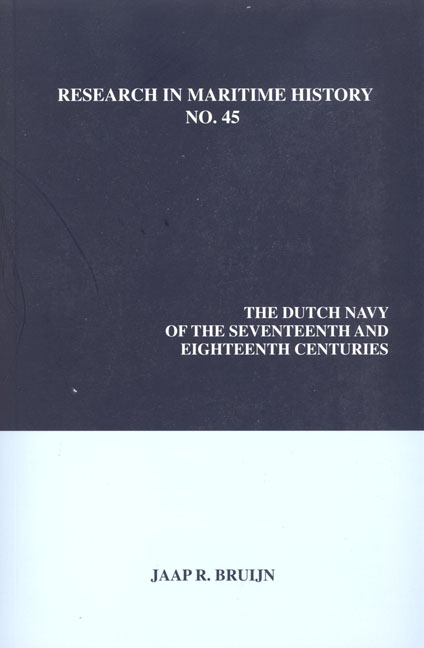Book contents
- Frontmatter
- Contents
- Illustrations
- Tables
- Series Editor's Foreword
- About the Author
- Introduction to the 2011 Edition
- Foreword
- Preface
- Introduction
- Map of the Dutch Republic
- Map of Dutch Naval Activity in European Waters
- Part One The “Old” Navy, Late 1500s-1652
- Part Two The “New” Navy, 1652-1713
- Part Three A Second-Rate Navy, 1714-1795
- Convoys and the Containment of the Barbary Corsairs
- Favouritism and Innovation
- Little Work, But More Education for the Naval Officer
- Naval Seaman, A Poor Man's Job
- Aftermath
- In Retrospect
- Bibliography
- Index
Convoys and the Containment of the Barbary Corsairs
from Part Three - A Second-Rate Navy, 1714-1795
- Frontmatter
- Contents
- Illustrations
- Tables
- Series Editor's Foreword
- About the Author
- Introduction to the 2011 Edition
- Foreword
- Preface
- Introduction
- Map of the Dutch Republic
- Map of Dutch Naval Activity in European Waters
- Part One The “Old” Navy, Late 1500s-1652
- Part Two The “New” Navy, 1652-1713
- Part Three A Second-Rate Navy, 1714-1795
- Convoys and the Containment of the Barbary Corsairs
- Favouritism and Innovation
- Little Work, But More Education for the Naval Officer
- Naval Seaman, A Poor Man's Job
- Aftermath
- In Retrospect
- Bibliography
- Index
Summary
During the previous period, the Dutch had unmistakably been one of the three leading sea powers. In spite of the fact that ever since the Third Anglo-Dutch War the Dutch had fewer ships-of-the-line than either England or France, it had nevertheless consistently followed the upward swing in the overall size of these countries’ navies. Dutch men-of-war too became larger and carried more guns. In fact, from about 1690 onward, only ships with fifty and more guns were regarded as ships-of-the-line. Table 4 illustrates the state of the Dutch navy around 1700 and at the end of the War of the Spanish Succession. These figures are evidence enough of the absolute and relative decline after that time. The downward trend continued until about 1780, much longer than it did for the British or French navy, while Spain and Russia emerged as new leading naval powers. The British navy continually outnumbered that of any other nation, but even in comparison with Spain's and Russia's, the Dutch could hardly have been called second-rate. From the 1740s onward, the Dutch navy was no longer a significant factor in European politics, its operations dealing mostly with convoys and skirmishes with Barbary Coast privateers.
Around 1713, it seemed as if the Dutch admiralties would have the opportunity to restore the balance in their budgets. Hardly any naval force had been fitted out for the Mediterranean in a year, while none had operated in the North Sea. Little attention had been paid to the struggles in the Nordic War. No ship was sent to sea in 1713, and only a few convoy vessels would be needed the following year. The debts, however, were too high to make quick recovery of the admiralties’ finances likely. Most provincial subsidies had not been received, and the receivers general of the admiralties had been unable to borrow sufficient cash on the money market - the last resort for them, but the admiralties’ credit was too poor. Even Holland was unable to give assistance. An enormous number of bills were left unpaid, mosdy those from captains and suppliers. Amsterdam had 6.5 million guilders owing, Rotterdam 3.3 million.
- Type
- Chapter
- Information
- The Dutch Navy of the Seventeenth and Eighteenth Centuries , pp. 129 - 140Publisher: Liverpool University PressPrint publication year: 2011



